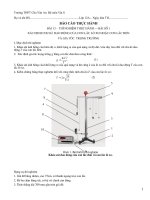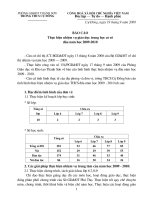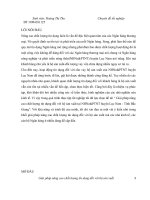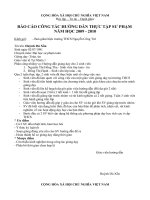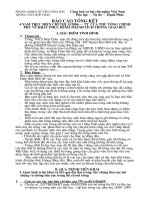BÁO CÁO THỰC TẬP-Java Coding Convention
Bạn đang xem bản rút gọn của tài liệu. Xem và tải ngay bản đầy đủ của tài liệu tại đây (416.5 KB, 26 trang )
THE MINISTRY OF SCIENCE, TECHNOLOGY AND ENVIRONTMENT
THE CORPORATION FOR FINANCING AND PROMOTING TECHNOLOGY
STANDARD
Java Coding Convention
Code
09be-HD/PM/HDCV/FSOFT
Version
1/1
Effective date
15/08/2003
Standard: Java Coding Convention Issue/Revision: 1/1
09be-HD/PM/HDCV/FSOFT 2/26
TABLE OF CONTENTS
Table of Contents 2
1 INTRODUCTION 4
1.1 Purpose 4
1.2 Application scope 4
1.3 Related documents 4
1.4 Definition 4
2 GENERAL RULES 5
2.1 Simple – Precise 5
2.2 Violations of Standard Rules 5
3 PROGRAM STRUCTURE 6
3.1 File Suffixes 6
3.2 Common File Names 6
4 FILE ORGANIZATION 7
4.1 Java Source Files 7
5 INDENTATION AND BRACES 9
5.1 Tab and Indent 9
5.2 Braces 9
5.3 Line Length 9
5.4 Wrapping Lines 9
6 COMMENTS 11
6.1 Implementation Comment Formats 11
6.2 Documentation Comments 12
7 DECLARATIONS 14
7.1 Number Per Line 14
7.2 Array Declaration 14
7.3 Initialization 14
7.4 Placement 14
7.5 Class and Interface Declarations 15
8 STATEMENTS 16
8.1 Simple Statements 16
8.2 Compound Statements 16
8.3 Return Statements 16
8.4 if, if-else, if else-if else Statements 16
8.5 for Statements 17
8.6 While Statements 17
8.7 Do-while Statements 17
8.8 Switch Statements 17
8.9 Try-catch Statements 18
9 WHITE SPACE 19
9.1 Blank Lines 19
9.2 Blank Spaces 19
Standard: Java Coding Convention Issue/Revision: 1/1
09be-HD/PM/HDCV/FSOFT 3/26
10 NAMING CONVENTIONS 20
10.1 General Rules 20
10.2 Class/Interface 20
10.3 Variables 20
10.4 Constants 21
10.5 Methods 21
11 PROGRAMMING PRACTICES 22
11.1 Providing Access to Instance and Class Variables 22
11.2 Referring to Class Variables and Methods 22
11.3 Constants 22
11.4 Variable Assignments 22
11.5 Loggings 23
11.6 Performance Practices 23
11.7 Miscellaneous Practices 23
12 CODE EXAMPLES 25
12.1 Java Source File Example 25
Standard: Java Coding Convention Issue/Revision: 1/1
09be-HD/PM/HDCV/FSOFT 4/26
1 INTRODUCTION
1.1 Purpose
Code conventions are important to programmers for a number of reasons:
80% of the lifetime cost of a piece of software goes to maintenance.
Hardly any software is maintained for its whole life by the original author.
Code conventions improve the readability of the software, allowing engineers to
understand new code more quickly and thoroughly.
If you ship your source code as a product, you need to make sure it is as well packaged and
clean as any other product you create.
1.2
Application scope
1.3
Related documents
No.
Code
Name of documents
1
04e-QT/PM/HDCV/FSOFT
Process description: Coding
2
SUN Java Coding Conventions
Java Language Specification – Sun Microsystems, Inc.
3
Proximus STD - JAVA - 01
Proximus Java Coding Standard, Issues 2.0
1.4 Definition
Terminology
Explanation
Standard: Java Coding Convention Issue/Revision: 1/1
09be-HD/PM/HDCV/FSOFT 5/26
2 GENERAL RULES
2.1 Simple – Precise
Keep your code simple and comprehensible.
Be precise and consistence
If you're sloppy and inconsistent with spaces, indentation, names, or access modifiers, what
confidence will people have that your logic is any more accurate?
Don’t optimize too soon
Unless you're doing I/O or performing the same operation a million times or more, forget
about optimising it until you've run the program under a profiler. (On the other hand, if you
develop an exponential-time algorithm with test cases of half a dozen elements, don't be too
surprised if performance is less than satisfactory on a real world data set of 10,000 rows!).
2.2 Violations of Standard Rules
No standard is perfect and no standard is applicable to all situations: sometimes you find
yourself in a situation where one or more standards do not apply.
Any violation to the guide is allowed if it enhances readability.
The main goal of the recommendation is to improve readability and thereby the understanding
and the maintainability and general quality of the code. It is impossible to cover all the specific
cases in a general guide and the programmer should be flexible.
When you go against the standard, document it.
All standards, except for this one, can be broken. If you do so, you must document why you
broke the standard, the potential implications of breaking the standard, and any conditions
that may/must occur before the standard can be applied to this situation.
The bottom line is that you need to understand each standard, understand when to apply
them, and just as importantly when not to apply them.
Projects may customize this document for its own need.
Base on customer requirements, projects may have to use coding standards provided by
customers or have to customize this coding standards document to meet some special
requirements of customers.
Standard: Java Coding Convention Issue/Revision: 1/1
09be-HD/PM/HDCV/FSOFT 6/26
3 PROGRAM STRUCTURE
This section lists commonly used file suffixes and names.
3.1 File Suffixes
Java Software uses the following file suffixes:
File Type
Suffix
Java source
.java
Java bytecode
.class
3.2 Common File Names
Frequently used file names include:
File Name
Use
README
The preferred name for the file that summarizes the contents of a particular
directory.
Standard: Java Coding Convention Issue/Revision: 1/1
09be-HD/PM/HDCV/FSOFT 7/26
4 FILE ORGANIZATION
A file consists of sections that should be separated by blank lines and an optional comment
identifying each section.
Files longer than 2000 lines or have more than 50 methods are cumbersome and should be
avoided.
For an example of a Java program properly formatted, see "Java Source File Example" on
page 19.
4.1 Java Source Files
Each Java source file contains a single public class or interface. When private classes and
interfaces are associated with a public class, you can put them in the same source file as the
public class. The public class should be the first class or interface in the file.
Java source files have the following ordering:
Beginning comments (see "Beginning Comments" on page 4)
Package and Import statements
Class and interface declarations (see "Class and Interface Declarations" on page 4)
4.1.1 Beginning Comments
All source files of a project should have consistent format of beginning comments, which can
contain information like class name, version information, date, copyright notice, modification
logs, etc.
Here is a recommended example of beginning comments format:
/*
* Classname
*
* Version information
*
* Date
*
* Copyright notice
*
* Modification Logs:
* DATE AUTHOR DESCRIPTION
*
* 10-Aug-2003 CuongDD Description of modification
*/
4.1.2 Package and Import Statements
The first non-comment line of most Java source files is a package statement. Within FSOFT,
all Java packages should always start with vn.fpt.fsoft., unless otherwise specified by
customers.
After that, import statements can follow. For example:
package vn.fpt.fsoft.fms;
import java.awt.peer.CanvasPeer;
Note: The first component of a unique package name is always written in all-lowercase ASCII
letters and should be one of the top-level domain names, currently com, edu, gov, mil, net,
org, or one of the English two-letter codes identifying countries as specified in ISO Standard
3166, 1981.
Standard: Java Coding Convention Issue/Revision: 1/1
09be-HD/PM/HDCV/FSOFT 8/26
4.1.3 Class and Interface Declarations
The following table describes the parts of a class or interface declaration, in the order that
they should appear. See "Java Source File Example" on page 19 for an example that includes
comments.
No
Part of Class/Interface Declaration
Notes
1
Class/interface documentation comment
(/** */)
See "Documentation Comments" on page 9 for
information on what should be in this comment.
2
class or interface statement
3
Class/interface implementation comment
(/* */), if necessary
This comment should contain any class-wide or
interface-wide information that wasn't appropriate
for the class/interface documentation comment.
4
Constants (static final)
First the public constants, then the
protected, then package level (no access
modifier), and then the private.
5
Class (static) variables
First the public class variables, then the
protected, then package level (no access
modifier), and then the private.
6
Instance variables
First public, then protected, then package
level (no access modifier), and then private.
7
Constructors
8
Methods
These methods should be grouped by functionality
rather than by scope or accessibility. For example, a
private class method can be in between two public
instance methods. The goal is to make reading and
understanding the code easier.
9
Inner classes/interfaces
Standard: Java Coding Convention Issue/Revision: 1/1
09be-HD/PM/HDCV/FSOFT 9/26
5 INDENTATION AND BRACES
5.1 Tab and Indent
Four spaces should be used as the unit of indentation.
Tab characters should be avoided because different editors interpret tabs differently.
Continuation indent should be configured to 8 spaces (two normal indentation levels).
5.2 Braces
Open curly brace “{” of class/method declarations and other code blocks should be at “END
OF LINE” of the first statement of code block.
5.3 Line Length
Avoid lines longer than 80 or 120 characters, since they're not handled well by many terminals
and tools.
Note: Examples for use in documentation should have a shorter line length-generally no more
than 70 characters.
5.4 Wrapping Lines
When an expression will not fit on a single line, break it according to these general principles:
Break after a comma.
Break after a logical operator.
Break before an operator.
Prefer higher-level breaks to lower-level breaks.
Align the new line with the beginning of the expression at the same level on the previous
line.
If the above rules lead to confusing code or to code that's squished up against the right
margin, just indent 8 spaces instead.
Here are some examples of breaking method calls:
someMethod(longExpression1, longExpression2, longExpression3,
longExpression4, longExpression5);
var = someMethod1(longExpression1,
someMethod2(longExpression2,
longExpression3));
Following are two examples of breaking an arithmetic expression. The first is preferred, since
the break occurs outside the parenthesized expression, which is at a higher level.
longName1 = longName2 * (longName3 + longName4 - longName5)
+ 4 * longname6; // PREFER
longName1 = longName2 * (longName3 + longName4
- longName5) + 4 * longname6; // AVOID
Standard: Java Coding Convention Issue/Revision: 1/1
09be-HD/PM/HDCV/FSOFT 10/26
Following are two examples of indenting method declarations. The first is the conventional
case. The second would shift the second and third lines to the far right if it used conventional
indentation, so instead it indents only 8 spaces.
//CONVENTIONAL INDENTATION
someMethod(int anArg, Object anotherArg, String yetAnotherArg,
Object andStillAnother) {
}
//INDENT 8 SPACES TO AVOID VERY DEEP INDENTS
private static synchronized horkingLongMethodName(int anArg,
Object anotherArg, String yetAnotherArg,
Object andStillAnother) {
}
Line wrapping for if statements should generally use the 8-space rule, since conventional (4
space) indentation makes seeing the body difficult.
For example:
//DON'T USE THIS INDENTATION
if ((condition1 && condition2) ||
(condition3 && condition4) ||
!(condition5 && condition6)) { //BAD WRAPS
doSomethingAboutIt(); //MAKE THIS LINE EASY TO MISS
}
//USE THIS INDENTATION INSTEAD
if ((condition1 && condition2) ||
(condition3 && condition4) ||
!(condition5 && condition6)) {
doSomethingAboutIt();
}
//OR USE THIS
if ((condition1 && condition2) || (condition3 && condition4) ||
!(condition5 && condition6)) {
doSomethingAboutIt();
}
Here are three acceptable ways to format ternary expressions:
alpha = (aLongBooleanExpression) ? beta : gamma;
alpha = (aLongBooleanExpression) ? beta
: gamma;
alpha = (aLongBooleanExpression)
? beta
: gamma;
Standard: Java Coding Convention Issue/Revision: 1/1
09be-HD/PM/HDCV/FSOFT 11/26
6 COMMENTS
Java programs can have two kinds of comments: implementation comments and
documentation comments. Implementation comments are those found in C++, which are
delimited by /* */, and //. Documentation comments (known as "doc comments") are Java-
only, and are delimited by /** */. Doc comments can be extracted to HTML files using the
javadoc tool.
Implementation comments are mean for commenting out code or for comments about the
particular implementation. Doc comments are meant to describe the specification of the code,
from an implementation-free perspective to be read by developers who might not necessarily
have the source code at hand.
Comments should be used to give overviews of code and provide additional information that is
not readily available in the code itself. Comments should contain only information that is
relevant to reading and understanding the program. For example, information about how the
corresponding package is built or in what directory it resides should not be included as a
comment.
Discussion of nontrivial or non-obvious design decisions is appropriate, but avoid duplicating
information that is present in (and clear from) the code. It is too easy for redundant
comments to get out of date. In general, avoid any comments that are likely to get out of date
as the code evolves.
Note: The frequency of comments sometimes reflects poor quality of code. When you feel
compelled to add a comment, consider rewriting the code to make it clearer.
Comments should not be enclosed in large boxes drawn with asterisks or other characters.
Comments should never include special characters such as form-feed and backspace.
6.1 Implementation Comment Formats
Programs can have four styles of implementation comments: block, single-line, trailing, and
end-of-line.
6.1.1 Block Comments
Block comments are used to provide descriptions of files, methods, data structures and
algorithms. Block comments may be used at the beginning of each file and before each
method. They can also be used in other places, such as within methods. Block comments
inside a function or method should be indented to the same level as the code they describe.
A block comment should be preceded by a blank line to set it apart from the rest of the code.
/*
* Here is a block comment.
*/
Block comments can start with /*-, which is recognized by indent(1) as the beginning of a
block comment that should not be reformatted. Example:
/*-
* Here is a block comment with some very special
* formatting that I want indent(1) to ignore.
*
* one
* two
* three
*/
Standard: Java Coding Convention Issue/Revision: 1/1
09be-HD/PM/HDCV/FSOFT 12/26
Note: If you don't use indent(1), you don't have to use /*- in your code or make any other
concessions to the possibility that someone else might run indent(1) on your code.
See also "Documentation Comments" on page 9.
6.1.2 Single-Line Comments
Short comments can appear on a single line indented to the level of the code that follows. If a
comment can't be written in a single line, it should follow the block comment format (see
section 5.1.1). A single-line comment should be preceded by a blank line. Here's an example
of a single-line comment in Java code (also see "Documentation Comments" on page 9):
if (condition) {
// Handle the condition.
}
6.1.3 Trailing Comments
Very short comments can appear on the same line as the code they describe, but should be
shifted far enough to separate them from the statements. If more than one short comment
appears in a chunk of code, they should all be indented to the same tab setting.
Here's an example of a trailing comment in Java code:
if (a == 2) {
return TRUE; // special case
} else {
return isPrime(a); // works only for odd a
}
6.1.4 End-Of-Line Comments
The // comment delimiter can comment out a complete line or only a partial line. It shouldn't
be used on consecutive multiple lines for text comments; however, it can be used in
consecutive multiple lines for commenting out sections of code. Examples of all three styles
follow:
if (foo > 1) {
// Do a double-flip.
} else {
return false; // Explain why here.
}
//if (bar > 1) {
// // Do a triple-flip.
//
//} else {
// return false;
//}
6.2 Documentation Comments
Note: See "Java Source File Example" on page 19 for examples of the comment formats
described here.
Standard: Java Coding Convention Issue/Revision: 1/1
09be-HD/PM/HDCV/FSOFT 13/26
For further details, you have to read "
How to Write Doc Comments for Javadoc
" which
includes information on the doc comment tags (@return, @param, @see):
For further details about doc comments and javadoc, see the javadoc home page at:
Doc comments describe Java classes, interfaces, constructors, methods, and fields. Each doc
comment is set inside the comment delimiters /** */, with one comment per class,
interface, or member. This comment should appear just before the declaration:
/**
* The Example class provides
*/
public class Example {
Notice that top-level classes and interfaces are not indented, while their members are. The
first line of doc comment (/**) for classes and interfaces is not indented; subsequent doc
comment lines each have 1 space of indentation (to vertically align the asterisks). Members,
including constructors, have 4 spaces for the first doc comment line and 5 spaces thereafter.
If you need to give information about a class, interface, variable, or method that isn't
appropriate for documentation, use an implementation block comment (see section 5.1.1) or
single-line (see section 5.1.2) comment immediately
after
the declaration. For example, details
about the implementation of a class should go in such an implementation block comment
following
the class statement, not in the class doc comment.
Doc comments should not be positioned inside a method or constructor definition block,
because Java associates documentation comments with the
first declaration
after
the
comment.
Standard: Java Coding Convention Issue/Revision: 1/1
09be-HD/PM/HDCV/FSOFT 14/26
7 DECLARATIONS
7.1 Number Per Line
One declaration per line is recommended since it encourages commenting. In other words,
int level; // indentation level
int size; // size of table
is preferred over
int level, size;
Do not put different types on the same line. Example:
int foo, fooarray[]; //WRONG!
Note: The examples above use one space between the type and the identifier. Another
acceptable alternative is to use tabs, e.g.:
int level; // indentation level
int size; // size of table
Object currentEntry; // currently selected table entry
7.2 Array Declaration
Though Java supports two styles of array declarations, we should only follow one as following:
int anIntArray[]; // AVOID
int[] anIntArray; // RECOMMENDED
7.3 Initialization
Try to initialize local variables where they're declared. The only reason not to initialize a
variable where it's declared is if the initial value depends on some computation occurring first.
7.4 Placement
Put declarations only at the beginning of blocks. (A block is any code surrounded by curly
braces "{" and "}".) Don't wait to declare variables until their first use; it can confuse the
unwary programmer and hamper code portability within the scope.
void myMethod() {
int int1 = 0; // beginning of method block
if (condition) {
int int2 = 0; // beginning of "if" block
}
}
The one exception to the rule is indexes of for loops, which in Java can be declared in the
for statement:
String tempString;
for (int i = 0; i < maxLoops; i++) {
tempString = ;
Standard: Java Coding Convention Issue/Revision: 1/1
09be-HD/PM/HDCV/FSOFT 15/26
}
Local variables used inside loops should be declared outside and right before the loop
statement, as shown in above example.
Avoid local declarations that hide declarations at higher levels. For example, do not declare
the same variable name in an inner block:
int count;
myMethod() {
if (condition) {
int count = 0; // AVOID!
}
}
7.5 Class and Interface Declarations
When coding Java classes and interfaces, the following formatting rules should be followed:
Opening bracket "{" always appears at end of line.
Closing bracket "}" should appear on a new line.
class Sample extends Object {
int ivar1;
int ivar2;
Sample(int i, int j) {
ivar1 = i;
ivar2 = j;
}
int emptyMethod() {
}
}
Methods are separated by a blank line
Standard: Java Coding Convention Issue/Revision: 1/1
09be-HD/PM/HDCV/FSOFT 16/26
8 STATEMENTS
8.1 Simple Statements
Each line should contain at most one statement. Example:
argv++; // Correct
argc ; // Correct
argv++; argc ; // AVOID!
8.2 Compound Statements
Compound statements are statements that contain lists of statements enclosed in braces "{
statements }". See the following sections for examples.
The enclosed statements should be indented one more level than the compound
statement.
The opening brace should be at the end of the line that begins the compound statement;
the closing brace should begin a line and be indented to the beginning of the compound
statement.
Braces are used around all statements, even single statements, when they are part of a
control structure, such as a if-else or for statement. This makes it easier to add
statements without accidentally introducing bugs due to forgetting to add braces.
8.3 Return Statements
A return statement with a value should not use parentheses unless they make the return
value more obvious in some way. Example:
return;
return myDisk.size();
return (size ? size : defaultSize);
8.4 if, if-else, if else-if else Statements
The if-else class of statements should have the following form:
if (condition) {
statements;
}
if (condition) {
statements;
} else {
statements;
}
if (condition) {
statements;
} else if (condition) {
statements;
} else {
statements;
}
Standard: Java Coding Convention Issue/Revision: 1/1
09be-HD/PM/HDCV/FSOFT 17/26
Note: if statements always use braces {}. Avoid the following error-prone form:
if (condition) //AVOID! THIS OMITS THE BRACES {}!
statement;
8.5 for Statements
A for statement should have the following form:
for (initialization; condition; update) {
statements;
}
An empty for statement (one in which all the work is done in the initialization, condition, and
update clauses) should have the following form:
for (initialization; condition; update);
When using the comma operator in the initialization or update clause of a for statement,
avoid the complexity of using more than three variables. If needed, use separate statements
before the for loop (for the initialization clause) or at the end of the loop (for the update
clause).
8.6 While Statements
A while statement should have the following form:
while (condition) {
statements;
}
An empty while statement should have the following form:
while (condition);
8.7 Do-while Statements
A do-while statement should have the following form:
do {
statements;
} while (condition);
8.8 Switch Statements
A switch statement should have the following form:
switch (condition) {
case ABC:
statements;
/* falls through */
case DEF:
statements;
break;
case XYZ:
statements;
break;
Standard: Java Coding Convention Issue/Revision: 1/1
09be-HD/PM/HDCV/FSOFT 18/26
default:
statements;
break;
}
Every time a case falls through (doesn't include a break statement), add a comment where
the break statement would normally be. This is shown in the preceding code example with
the /* falls through */ comment.
Every switch statement should include a default case. The break in the default case is
redundant, but it prevents a fall-through error if later another case is added.
8.9 Try-catch Statements
A try-catch statement should have the following format:
try {
statements;
} catch (ExceptionClass e) {
statements;
}
A try-catch statement may also be followed by finally, which executes regardless of
whether or not the try block has completed successfully.
try {
statements;
} catch (ExceptionClass e) {
statements;
} finally {
statements;
}
Standard: Java Coding Convention Issue/Revision: 1/1
09be-HD/PM/HDCV/FSOFT 19/26
9 WHITE SPACE
9.1 Blank Lines
Blank lines improve readability by setting off sections of code that are logically related.
Two blank lines should always be used in the following circumstances:
Between sections of a source file
Between class and interface definitions
One blank line should always be used in the following circumstances:
Between methods
Between the local variables in a method and its first statement
Before a block (see section 5.1.1) or single-line (see section 5.1.2) comment
Between logical sections inside a method to improve readability
9.2 Blank Spaces
Blank spaces should be used in the following circumstances:
A keyword followed by a parenthesis should be separated by a space. Example:
while (true) {
}
Note that a blank space should not be used between a method name and its opening
parenthesis. This helps to distinguish keywords from method calls.
A blank space should appear after commas in argument lists.
All binary operators except . should be separated from their operands by spaces. Blank
spaces should never separate unary operators such as unary minus, increment ("++"),
and decrement (" ") from their operands. Example:
a += c + d;
a = (a + b) / (c * d);
while (d++ = s++) {
n++;
}
printSize("size is " + foo + "\n");
The expressions in a for statement should be separated by blank spaces. Example:
for (expr1; expr2; expr3)
Casts should be followed by a blank space. Examples:
myMethod((byte) aNum, (Object) x);
myMethod((int) (cp + 5), ((int) (i + 3)) + 1);
Standard: Java Coding Convention Issue/Revision: 1/1
09be-HD/PM/HDCV/FSOFT 20/26
10 NAMING CONVENTIONS
Naming conventions make programs more understandable by making them easier to read.
They can also give information about the function of the identifier-for example, whether it's a
constant, package, or class-which can be helpful in understanding the code.
10.1 General Rules
This section outlines the rules to be followed while naming Source File / variable / control /
method.
i. Programmer defined names should be functionally meaningful, and should indicate the purpose of
the file / variable / control / method in question.
ii. Use terminology applicable to the domain.
If your users refer to their clients as customers, then use the term Customer for the class, not
Client.
Many developers will make the mistake of creating generic terms for concepts when perfectly good
terms already exist in the industry/domain.
iii. Identifiers must be as short as possible without obscuring their meaning, preferably 20 characters
or less.
Excessively long variable names are cumbersome and irritating for programmers to use,
hence chances of error during coding are higher.
iv. Avoid names that are similar or differ only in case.
For example, the variable names persistentObject and persistentObjects should not be used
together, nor should anSqlDatabase and anSQLDatabase
v. Avoid cryptic names, even in case of scratch pad variables or counters.
Bad or cryptic names waste programmer effort. Time is spent in just understanding the role of the
variable/control/method rather than in understanding functionality or solving a problem.
vi. Abbreviations in names should be avoided.
Domain specific phrases that are more naturally known through their acronym or abbreviations
should be kept abbreviated.
computeAverage(); // NOT: compAvg();
generateHTML(); // NOT: generateHypertextMarkupLanguage();
Unambiguous abbreviations should be used wherever possible. For example, use custName instead of
customerName. Capitalize the whole abbreviation.
vii. The method name should not contain any special characters other than underscore.
Use underscores only while naming constants (see below)
10.2 Class/Interface
Each class/interface name must start with uppercase and respect the general rules of above
naming convention (see 10.1), e.g. class CustomerBean.
Exception classes should be suffixed with Exception, e.g. LMSFunctionalException.
Interfaces having no method should be prefixed with I, e.g. IConstants.
Abstract classes should be prefixed with Abstract, e.g. abstract class AbstractBean.
Implementation classes should be suffixed with Impl, e.g. class CustomerBOImpl
implements CustomerBO.
10.3 Variables
Each variable name must start with lowercase and respect the general rules of naming
convention (see 10.1), e.g. custName.
List variables (of type Collection/List) should be suffixed with List, e.g. Collection
custList.
Standard: Java Coding Convention Issue/Revision: 1/1
09be-HD/PM/HDCV/FSOFT 21/26
Set variables (of type Set/HashSet) should be suffixed with Set, e.g. Set custSet = new
HashSet();
Map variables (of type Map/HashMap/TreeMap) should be suffixed with Map, e.g. Map custMap
= new TreeMap();
Array variables can be suffixed with Array, e.g. int[] custIDArray;
The use of ID or Id should be consistent throughout an application.
10.4 Constants
The following guidelines should be followed while naming constants:
Respect the general rules of naming convention (see 10.1).
All constants to be named in uppercase letters, with underscore between words.
All constants must be declared as static final.
10.5 Methods
The following guidelines to be followed while naming methods in class files:
Respect the general rules of naming convention (see 10.1).
Method name must start with lowercase letter.
Usually use “active verb” as the first word of method name. Here are some common verbs:
getCustomerID, setCustomerID
isActive, hasAddresses
findCustomers, searchCustomers
computeSalary, calculateSalary
initializeParameters, initParameters
addCustomer, removeCustomer
insertCustomer, deleteCustomer
updateCustomer, modifyCustomer, amendCustomer
openConnection, closeConnection, saveFile
createBuffer, destroyBuffer
startProcess, stopProcess
Verbs should be used by pairs and should be used consistently throughout an application.
Some special methods not starting with verbs:
Factory methods: newCustomer(), newCustomerBO()
Conversion methods: toString(), toLongPhoneNumber(), toXXX()
Standard: Java Coding Convention Issue/Revision: 1/1
09be-HD/PM/HDCV/FSOFT 22/26
11 PROGRAMMING PRACTICES
11.1 Providing Access to Instance and Class Variables
Don't make any instance or class variable public without good reason. Often, instance
variables don't need to be explicitly set or gotten-often that happens as a side effect of
method calls.
One example of appropriate public instance variables is the case where the class is essentially
a data structure, with no behavior. In other words, if you would have used a struct instead
of a class (if Java supported struct), then it's appropriate to make the class's instance
variables public.
11.2 Referring to Class Variables and Methods
Avoid using an object to access a class (static) variable or method. Use a class name instead.
For example:
classMethod(); //OK
AClass.classMethod(); //OK
anObject.classMethod(); //AVOID!
11.3 Constants
Numerical constants (literals) should not be coded directly, except for -1, 0, and 1, which can
appear in a for loop as counter values.
11.4 Variable Assignments
Avoid assigning several variables to the same value in a single statement. It is hard to read.
Example:
fooBar.fChar = barFoo.lchar = 'c'; // AVOID!
Do not use the assignment operator in a place where it can be easily confused with the
equality operator. Example:
if (c++ = d++) { // AVOID! (Java disallows)
}
should be written as
if ((c++ = d++) != 0) {
}
Do not use embedded assignments in an attempt to improve run-time performance. This is
the job of the compiler. Example:
d = (a = b + c) + r; // AVOID!
should be written as
a = b + c;
d = a + r;
Standard: Java Coding Convention Issue/Revision: 1/1
09be-HD/PM/HDCV/FSOFT 23/26
11.5 Loggings
Each Java application should use a configurable logging mechanism that supports different log
levels and allows turning on/off of some levels at runtime. The following are well-known
logging components available for use:
Log4J component from Jakarta open source projects, which is widely used in J2EE applications.
Proximus ClientLog component, which is widely used in all Proximus projects.
System.out.println() should not be used for loggings. Developers may use it to debug
in unit tests but it should be removed from source codes after unit tests.
11.6 Performance Practices
11.6.1 File Operations
File read operations must be restricted to a minimum. Instead of reading different parameters
from the same parameter file again and again, it’s better to load the entire parameter file into
memory once and read its contents from the memory thereafter.
11.6.2 StringBuffer vs. String
When concatenating strings, especially through a loop, use StringBuffer instead of
String to minimize number of unnecessary String objects.
11.6.3 Clear content of big structure after use
It’s a good practice to always clear() the content of Collection/Map objects after use.
11.6.4 Be economical when creating new objects
Too many objects created will eat up lots of system resources and impact load/performance of
an application. So always avoid unnecessary objects from creation.
11.7 Miscellaneous Practices
11.7.1 Parentheses
It is generally a good idea to use parentheses liberally in expressions involving mixed
operators to avoid operator precedence problems. Even if the operator precedence seems
clear to you, it might not be to others-you shouldn't assume that other programmers know
precedence as well as you do.
if (a == b && c == d) // AVOID!
if ((a == b) && (c == d)) // RIGHT
11.7.2 Returning Values
Try to make the structure of your program match the intent. Example:
if (booleanExpression) {
return true;
} else {
return false;
}
should instead be written as
return booleanExpression;
Similarly,
if (condition) {
var = x;
Standard: Java Coding Convention Issue/Revision: 1/1
09be-HD/PM/HDCV/FSOFT 24/26
} else {
var = y;
}
should be written as
var = (condition) ? x : y;
11.7.3 Expressions before ‘?' in the Conditional Operator
If an expression containing a binary operator appears before the ? in the ternary ?:
operator, it should be parenthesized. Example:
(x >= 0) ? x : -x;
11.7.4 Special Comments
Use XXX in a comment to flag something that is bogus but works.
Use FIXME to flag something that is bogus and broken.
11.7.5 toString() method
Consider overriding toString() to produce a useful description of the object (e.g. the type
of the object and the value of any unique id it contains).
To avoid confusion, toString() on two objects should normally be equal if and only if
equals() is true.
11.7.6 equals() / hashCode()
If a class implements equals() method, it must also implements hashCode() method, with a
rule that hash codes of 2 instances are only equal if they are equals().
Standard: Java Coding Convention Issue/Revision: 1/1
09be-HD/PM/HDCV/FSOFT 25/26
12 CODE EXAMPLES
12.1 Java Source File Example
The following example shows how to format a Java source file containing a single public class.
Interfaces are formatted similarly. For more information, see "Class and Interface
Declarations" on page 4 and "Documentation Comments" on page 9
/*
* @(#)Blah.java 1.82 99/03/18
*
* Copyright (c) 1994-1999 Sun Microsystems, Inc.
* 901 San Antonio Road, Palo Alto, California, 94303, U.S.A.
* All rights reserved.
*
* This software is the confidential and proprietary information of Sun
* Microsystems, Inc. ("Confidential Information"). You shall not
* disclose such Confidential Information and shall use it only in
* accordance with the terms of the license agreement you entered into
* with Sun.
*/
package java.blah;
import java.blah.blahdy.BlahBlah;
/**
* Class description goes here.
*
* @author Firstname Lastname
* @version 1.82 18 Mar 1999
*/
public class Blah extends SomeClass {
/* A class implementation comment can go here. */
/** classVar1 documentation comment */
public static int classVar1;
/**
* classVar2 documentation comment that happens to be
* more than one line long
*/
private static Object classVar2;
/** instanceVar1 documentation comment */
public Object instanceVar1;
/** instanceVar2 documentation comment */
protected int instanceVar2;
/** instanceVar3 documentation comment */
private Object[] instanceVar3;
/**
* constructor Blah documentation comment
*/
public Blah() {
// implementation goes here
}
/**
* method doSomething documentation comment
*/
public void doSomething() {

